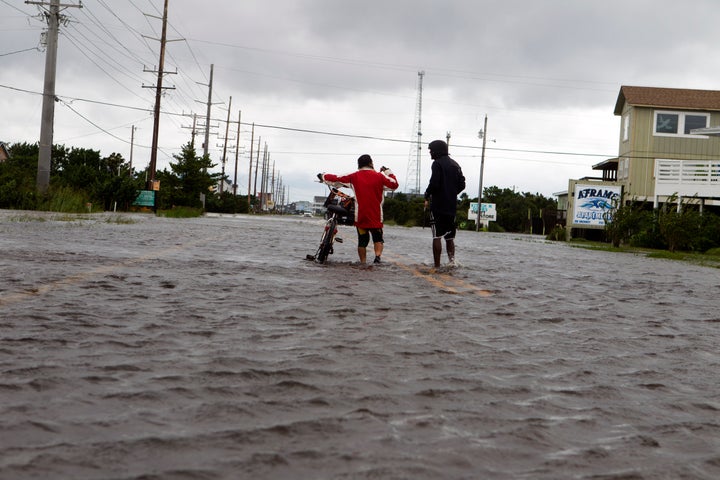As the COVID-19 pandemic continues to wreak havoc across the nation, federal forecasters are predicting an “above-normal” hurricane season in the Atlantic and “near- or below-normal” cyclone activity in the central Pacific.
In a call with reporters Thursday to announce the Atlantic outlook, Neil Jacobs, the acting administrator of the National Oceanic and Atmospheric Administration, said “an above-normal season is most likely, with a possibility of that season being extremely active.”
The agency forecasts between 13 and 19 named storms, 6 to 10 hurricanes and 3 to 6 major hurricanes (Category 3 or higher). The season would mark a record five-year streak of severe storm seasons, beating the previous four-year record from 1998 to 2001.
“At this time, it is not possible to predict how many of these potential storms will land,” Jacobs said.
But Gerry Bell, a hurricane climate specialist and research meteorologist at the NOAA’s Climate Prediction Center in Camp Springs, Maryland, warned: “The 2020 Atlantic hurricane season is expected to be a busy one.”

The federal forecast lines up with several organizations that have already released 2020 seasonal outlooks warning of above-average Atlantic hurricane activity.
The 2020 season officially begins on June 1. But over the weekend Tropical Storm Arthur, this year’s first named storm, formed in the Atlantic, battering Southeastern states with winds and rain before dissipating after three days. It marked the eighth preseason storm in the past decade, a sign, scientists say, of warming oceans.
Despite the warnings, and a series of bungled White House responses to major storms over the past few years, officials on the call tried to strike a reassuring tone. Commerce Secretary Wilbur Ross, under whose agency NOAA falls, kicked off the press conference with boastful claims about investments the administration is making in meteorological technology.
The researchers on the call downplayed the significance of human-caused climate change on the severity of the upcoming season. They pointed instead to the cyclical impacts of El Niño and La Niña, the warming and cooling effects, respectively, of ocean currents on the atmosphere.
“Those are really dominant signals and they’re controlling the strength of the hurricane season,” Bell said.
On Monday, researchers at NOAA and the University of Wisconsin at Madison published a study that found that planetary warming over the last 40 years increased the likelihood of tropical storms becoming major hurricanes ― anything over a Category 3 ― by 8% per decade.
Asked if the agency is seeing that climate signal in the modeling for the 2020 season, Bell said it is “not a factor in this year’s forecast.”
“Whether ultimately we have more hurricanes at the top of the Category 4 and 5 ― the particular study you’re referring to ― well, we’re not sure,” he said. “We’re seeing it globally, but because of these other climate signals in the Atlantic, we’re just not sure if we’re seeing anything above those other climate signals yet.”
He said storms’ intensity may be less significant than other factors linked to climate change.
“Don’t get locked into just the ultimate hurricane strength,” he said. “There’s other issues with global warming such as rising ocean temperatures. Warmer waters mean higher sea levels. Higher sea levels mean more storm inundation as a hurricane’s approaching.”
“The problem with that,” he added, “is coastlines have built up tremendously over the last several decades, so that there’s potentially many more millions more people in harm’s way.”
The Federal Emergency Management Agency said officials were prepared to implement social distancing measures in evacuation centers, but warned “there’s always a challenge having enough” space and urged those displaced by storms to seek shelter with loved ones.
“The 2020 Atlantic hurricane season is expected to be a busy one.”
- Gerry Bell, NOAA research meteorologist
“Evacuation centers are meant to keep you safe, but they’re not meant to keep you comfortable,” Carlos Castillo, FEMA’s acting deputy administrator for resilience, said on the call.
The forecasts come on the heels of a 2019 Atlantic hurricane season that tied 1969 as the fourth most active season on record. There were 18 named storms, six hurricanes and three major hurricanes. The worst of them was Dorian, which slammed into the northern Bahamas as a monster Category 5 hurricane ― the strongest to make landfall in the island nation’s recorded history ― devastating the islands of Abaco and Grand Bahama and causing at least $3.4 billion in damage. At least 70 people died and some 30,000 were left homeless. Climate scientists called it “a preview of the climate crisis to come.”
The Atlantic forecast comes a day after NOAA announced a 75% chance of a “near- or below-normal” season in the central Pacific. Two to six tropical cyclones are expected to develop there.
